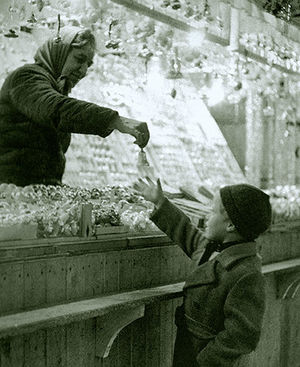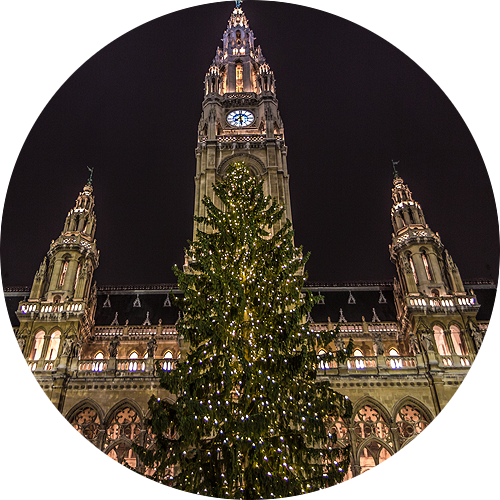

The changing Christkindlmarkt
It is evening and the festively decorated stands of the Wiener Christkindlmarkt shine brightly in the darkness.
I stroll past punch and colourful candles, pause at the sweets or the small snow globes and dig my hands deeper into the pockets of my coat to protect them from the cold. It starts snowing and for a few steps, I close my eyes and enjoy the calm atmosphere. As I open my eyes and take a look around again, I noticed an extraordinary stand. It looks very old-fashioned with ancient lighting. There are fewer lebkuchen on sale here than on the other side of the Christkindlmarkt. The man stood in the stall, beckons me to come over with red cheeks and gives me radiant smile, as I accept his invitation.
I smile back and look at the shiny lebkuchen, as he speaks to me: “Grüß Gott! My name is Thomas and I work as a lebkuchen maker. I’ve existed on the Wiener Christkindlmarkt since 1600 and let me tell you something, I have experienced quite a bit in the last 400 years. I am what you call a time-honoured institution like the Christkindlmarkt itself and I know my way around. If you want, I can tell you a little about its interesting history – it won’t even take that long and here at my stand it’s already a lot warmer, wouldn’t you agree?”
He tell me all of this with an open smile on his face and you notice that he is completely serious. All I am capable of doing is stare at him with my mouth wide open. He ignores my expression, gives me an encouraging piece of lebkuchen and starts speaking again: “Well, there are different views with regard to when the Christkindlmarkt was first opened. Can one name a winter market of 1382 the ancestor of the Christkindlmarkt? It was in this year that Albert III, Duke of Austria extended the market hours, this is what my dear old mother told me. And this is why a fine market existed on the 25th November, which is 14 days before and 14 days after St. Kathrein. The market was not usually Christmassy – I don’t know anything about the festive offers –, but it was definitely wintery and cold. In my opinion, these are the best conditions to become a large Christmas market!” Thomas chuckles and it seems to me that this show is also a good PR stunt. So I hesitantly taste the lebkuchen, while Thomas takes a sip out of a worn out cup and continues with the story.
“It becomes a little more official with the relocation to the Graben in 1600. At this “Thomas market” confectioners and lebkuchen markers like myself, sold our goods. Thomas market... you must think that I am crazy ...? - Yes, it is true, the market is named after me! After all, I was the first and the best lebkuchen maker on site! I was loved by all, especially the children. Others believe that the name comes from Thomas the apostle, who celebrates his feast day on the 21st December. Darn it!! The honest lebkuchen makers never receive any recognition!” I nodded sympathetically and had to refrain from smiling – as if a market was named after a lebkuchen maker! Even if his lebkuchen are in fact extremely tasty.
Relocation
“1772 my market moved to the Freyung and – finally! It is named the St. Nicholas and Christmas market and now it really is a Christmassy market! It was named the St. Nicholas market because back then, the big bushy bearded man was still responsible for the gifts – the Christ Child took over this responsibility a while later. However, my offer was still the same and unchanged, even on the Freyung, sweets are simply always the best.” He proudly knocks the tabletop next to his lebkuchen. “The other vendors, who were on the regular market did not like this at all because it often resulted in fisticuffs between both parties. A crazy idea to organise a Christmas market and a normal annual fair at the same time. When it all became too colourful, we, the people of the Christmas market had to quit and move to the area Am Hof. – Bless you!”, Thomas added as I sneezed twice and hastily said thank you. Once again Thomas takes a sip out of his cup.
“So in 1842 I was at Am Hof and let me tell you something, it was bustling all around me: Trades with tinsel angels, silver-coated nuts, tinsel, candles, textiles and so forth were being carried out all around me. Most importantly however, – and it is important that you hear this – the name change took place on the way to Am Hof from the Freyung: For the very first time the hundred plus stands were named as the ‘Christkindlmarkt’! So whoever is particularly meticulous, this market at the Rathausplatz is 170 years young.” Thomas smiles as though this idea was most ridiculous thing he ever heard. Then his expression became a little more serious:

Electrical light

“In 1872 I was very happy to be working on the Christkindlmarkt because that was the year in which the annual fairs in Vienna were stopped – and my market was allowed to remain. The reason for this was that the annual fairs in the modern city became obsolete – the point of view of the city of Vienna. Well, what can I say ... In 1903 as a Christkindlmarkt vendor I was able to experience how electrical light was used for the lighting of the stands for the first time. Seeing your goods in artificial light was a very special feeling – the advance also found its way into the Christkindlmarkt!”
The old man pointed to the old-fashioned lighting and I too started sense a special feeling in the pit of my stomach. Is this all really a PR stunt? Or is Thomas... really a vendor from the 17th century? So why are no other people coming to us, we must be easily visible even in this snow flurry?
“We were able to enjoy the calm for a few more years, but then 1923 the Christkindlmarkt restlessly looked for accommodation – which, of course is very symbol for the Christmas period. Then my lebkuchen were available at Stephansplatz, Neubaugürtel or in front of the Messepalast. In 1963 they tried it with the Kalvarienberggasse, which turn out to be utter nonsense – however, that was because of the vendors that offered normal things such as colanders, grindstones and soup pots! The people of Vienna did not like this on bit and the rush was correspondingly moderate ... The everlasting migration of the market started to annoy many people but unfortunately a permanent accommodation could simply not be found.
Finally at the Rathausplatz

Although the Rathausplatz was already mentioned in 1963, it took quite a while before it was tried there.” He pulled out a crinkly yellowed newspaper out and show it to me: “Even the ‘Stadt Wien’ newspaper in 1972 was of the opinion that the Christkindlmarkt could ‘finally find a dignified and permanent location in front of the silhouette of the neo-Gothic magnificent building [..] - the author, Mr Kaut must have been delighted when the Christkindlmarkt finally arrived at the Rathausplatz in 1975. Just like me, because since we were finally able to stay here, the atmosphere became more and more beautiful and festive! The booths were generously draped with goods so that everything could be seen and most importantly, it could all be seen from far away. Or simply as a small child. The toy merchants were particularly fond of using their canopies so that the little ones could see everything as well as possible. The market office made an appearance in 1978. After all there were regulations against such hangings on the huts. They briefly and concisely imposed an ‘air tax’. Anyone that wanted to hang something on the canopy had to pay a fee. The vendors were stunned and protested by simply keeping their stands closed! And all this happened on the very day that a television crew was announced. This protest was quickly very successful: The air tax was abolished and now things could be hung on the canopies. Even small successes must be celebrated.” Thomas shows me one more article about the air tax. I skim through it and have to giggle – today such hangings are common practice.
“Not just the offer but even the programme became more and more diverse. A lot has happened, particularly since 2007. This association that has a very long....”, Thomas quickly ponders. “Ah, yes, the Verein zur Förderung des Marktgewerbe [The Association for the Promotion of the Market Industry! This association then took over the organisation of the Christkindlmarkt. The best part is: The chairman of the association is Turkish by birth! And every year, he gets to work with a lot of enthusiasm so that everything is more beautiful and festive – I think it’s amazing! Of course the changes slowly had to take place, you see the Viennese folk are creatures of habit. But meanwhile there are wonderful Christmas things available, especially for the children! For example, the Himmelsbühne [heavenly stage], where the Christ Child reads aloud. Anyway the stage is so much better under the Christmas tree than the nativity scene. Don’t get me wrong, I love the nativity scene. However, under the tree it was much too loud and hectic – how are you meant to observe it devoutly or tell Christmas stories? Not to worry, the current location of the nativity scene is so much better and most importantly, it’s quieter.”
No a fairground
“Yes that is right ...” I say something for the first time and contemplatively add: “It is good to see how you are trying to ensure that the Christkindlmarkt does not turn into a fairground.” Thomas nods briskly. “Exactly! You know what, I think the new lights are particularly lovely! It’s as if the tourist like to do nothing more than take photos of the lights”, he winks. I wink back and think of what I should do next: Should I say thank you for the performance and the lebkuchen? Or should I rather not compare the magic that surrounding this hut with something as despicable as a PR stunt? I shyly look at the floor and decide to say thank you for the sweets. As I say thank, Thomas makes a dismissive hand gesture and just says that I should stop by the next time I am around and of course, I promise I will.
I then wave to say good bye and make my way through the snow towards the underground.
© Christine Schäffer
